Microstructure and Mechanical Properties of Multiple In-Situ-Phases-Reinforced Nickel Composite Coatings Deposited by Wide-Band Laser
Abstract
:1. Introduction
2. Materials and Methods
2.1. Materials
2.2. Laser Cladding Process
2.3. Materials Characterization
3. Results
3.1. Macro Observation and Phase Constitution
3.2. Microstructure and Elemental Distribution
3.3. TEM Characterization
3.4. Mechanical Properties
4. Discussion
5. Conclusions
- The microstructure analysis showed that the microstructure of the coating 1# with the least Ti and B4C addition was mainly composed of equiaxial grains. The content of in-situ precipitates distributed at the interdendritic space in coating 1#. As the adscititious Ti and B4C increased in coating 2# and 3#, the needle-like precipitates, block precipitates and lamellar eutectics were also significantly increased.
- XRD patterns and TEM characterization confirmed that the multiple in-situ phases consist of Cr7C3, Cr23C6, TiC, CrB and TiB. It is believed that B4C was fully decomposed in the laser molten pool, which promotes the formation of various in-situ precipitated phases.
- Mechanical properties of composite coatings were evaluated by nanoindentation tests. Results indicated the elastic modulus was approximately 240 GPa, which changed slightly in the different coatings. In the contrast, the microhardness increased to the maximum 7.18 GPa in the coating with 10 wt.% Ti and B4C addition. The average friction coefficient of composite coating was about 0.50.
Author Contributions
Funding
Institutional Review Board Statement
Informed Consent Statement
Data Availability Statement
Conflicts of Interest
References
- Feldshtein, E.E.; Dyachkova, L.N. Wear minimization for highly loaded iron-based MMCs due to the formation of spongy-capillary texture on the friction surface. Wear 2020, 444–445, 203161. [Google Scholar] [CrossRef]
- Fu, S.; Yang, L.; Wang, P.; Wang, S.; Li, Z. Comparison of the microstructure evolution and wear resistance of Ti6Al4V composite coatings reinforced by hard pure or Ni-plated cubic boron nitride particles prepared with laser cladding on a Ti6Al4V substrate. Coatings 2020, 10, 702. [Google Scholar] [CrossRef]
- Ping, X.; Fu, H.; Sun, S.; Lin, J.; Guo, X.; Lei, Y. Microstructure and performance of Nb-bearing Ni60A-Cr3C2 Coatings Manufactured by Laser Cladding. Surf. Eng. 2020, 12, 1294–1306. [Google Scholar] [CrossRef]
- Zhao, Y.; Yu, T.; Sun, J.; Jiang, S. Microstructure and properties of laser cladded B4C/TiC/Ni-based composite coating. Int. J. Refract. Metals Hard Mater. 2020, 86, 105112. [Google Scholar] [CrossRef]
- Gou, Q.; Xiong, J.; Guo, Z.; Liu, J.; Yang, L.; Li, X. Influence of NbC additions on microstructure and wear resistance of Ti(C,N)-based cermets bonded by CoCrFeNi high-entropy alloy. Int. J. Refract. Metals Hard Mater. 2020, 94, 105375. [Google Scholar] [CrossRef]
- Venkatesh, L.N.; Babu, P.S.; Gundakaram, R.C.; Doherty, R.D.; Joshi, S.V.; Samajdar, I. Morphology-dependent hardness of Cr7C3-Ni-Rich alloy composite vs orientation independent hardness of Cr7C3 primary phase in a laser clad microstructure. Metall. Mater. Trans. A 2017, 48, 1534–1539. [Google Scholar] [CrossRef]
- Qunshuang, M.; Haozhe, C.; Hui, Z.; Wei, M.; Lei, H.; Huadong, L.; Yitao, W.; Xiaohui, Y. The alloying effects of Cr on in-situ phase evolution and wear resistance of nickel composite coatings fabricated by wide-band laser deposition. Surf. Coat. Technol. 2020, 397, 126019. [Google Scholar] [CrossRef]
- Xia, M.; Liu, A.; Lin, Y.; Li, N.; Ding, H.; Zhong, C. Densification behavior, microstructure evolution and fretting wear performance of in-situ hybrid strengthened Ti-based composite by laser powder-bed fusion. Vacuum 2019, 160, 146–153. [Google Scholar] [CrossRef]
- Zhang, M.; Li, M.; Chi, J.; Wang, S.; Ren, L.; Fang, M. Microstructure and tribology properties of in-situ MC(M:Ti, Nb) coatings prepared via PTA technology. Vacuum 2019, 160, 264–271. [Google Scholar] [CrossRef]
- Sun, S.; Fu, H.; Ping, X.; Guo, X.; Lin, J.; Lei, Y.; Wu, W.; Zhou, J. Effect of CeO2 addition on microstructure and mechanical properties of in-situ (Ti, Nb)C/Ni coating. Surf. Coat. Technol. 2019, 359, 300–313. [Google Scholar] [CrossRef]
- Gopinath, M.; Karmakar, D.P.; Nath, A.K. In-process detection of microstructural changes in laser cladding of in-situ Inconel 718/TiC metal matrix composite coating. J. Alloys Compd. 2018, 740, 545–558. [Google Scholar]
- Sun, S.; Fu, H.; Ping, X.; Lin, J.; Lei, Y.; Wu, W.; Zhou, J. Reinforcing behavior and microstructure evolution of NbC in laser cladded Ni45 coating. Appl. Surf. Sci. 2018, 455, 160–170. [Google Scholar] [CrossRef]
- Verdi, D.; Múnez, C.J.; Garrido, M.A.; Poza, P. Process parameter selection for Inconel 625-Cr3C2 laser cladded coatings. Int. J. Adv. Manuf. Technol. 2017, 92, 3033–3042. [Google Scholar] [CrossRef]
- Yang, H.; Gao, T.; Wu, Y.; Zhang, H.; Nie, J.; Liu, X. Microstructure and mechanical properties at both room and high temperature of in-situ TiC reinforced Al–4.5Cu matrix nanocomposite. J. Alloys Compd. 2018, 767, 606–616. [Google Scholar] [CrossRef]
- Cao, L.; Xia, Y.; Cui, H.; Li, Q.; Zhu, B.; Wang, Q. Microstructural characteristics of TiB2–TiC–NiAl composite coatings via plasma cladding process. Surf. Eng. 2019, 35, 997–1002. [Google Scholar] [CrossRef]
- Hu, Y.; Zhao, B.; Ning, F.; Wang, H.; Cong, W. In-situ ultrafine three-dimensional quasi-continuous network microstructural TiB reinforced titanium matrix composites fabrication using laser engineered net shaping. Mater. Lett. 2017, 195, 116–119. [Google Scholar] [CrossRef]
- Jażdżewska, M. Effects of CO2 and Nd:YAG laser remelting of the Ti6Al4V alloy on the surface quality and residual stresses. Adv. Mater. Sci. 2020, 20, 82–90. [Google Scholar] [CrossRef]
- Kik, T. Heat source models in numerical simulations of laser welding. Materials 2020, 13, 2653. [Google Scholar] [CrossRef]
- Pańcikiewicz, K.; świerczyńska, A.; Hućko, P.; Tumidajewicz, M. Laser dissimilar welding of AISI 430F and AISI 304 stainless steels. Materials 2020, 13, 4540. [Google Scholar] [CrossRef]
- Nepapushev, A.; Moskovskikh, D.; Vorotilo, K.; Rogachev, A. TiAl-based materials by in situ selective laser melting of Ti/Al reactive composites. Metals 2020, 10, 1505. [Google Scholar] [CrossRef]
- Tang, B.; Tan, Y.; Xu, T.; Sun, Z.; Li, X. Effects of TiB2 particles content on microstructure, mechanical properties and tribological properties of Ni-based composite coatings reinforced with TiB2 particles by laser cladding. Coatings 2020, 10, 813. [Google Scholar] [CrossRef]
- Bai, L.; Li, J.; Chen, J.; Song, R.; Shao, J.; Qu, C. Effect of the content of B4C on microstructural evolution and wear behaviors of the laser-clad coatings fabricated on Ti6Al4V. Opt. Laser Technol. 2016, 76, 33–45. [Google Scholar] [CrossRef]
- Yilbas, B.S.; Patel, F.; Karatas, C. Laser controlled melting of HSLA steel surface with presence of B4C particles. Appl. Surf. Sci. 2013, 282, 601–606. [Google Scholar] [CrossRef]
- Ma, Q.; Li, Y.; Yin, X.; Meng, W. Effects of laser fluence on microstructure and bonding characteristics of wideband laser-deposited nickel composite coatings. J. Mater. Eng. Perform. 2019, 28, 2661–2671. [Google Scholar] [CrossRef]
- Farahmand, P.; Kovacevic, R. An experimental–numerical investigation of heat distribution and stress field in single- and multi-track laser cladding by a high-power direct diode laser. Opt. Laser Technol. 2014, 63, 154–168. [Google Scholar] [CrossRef]
- Lei, Y.; Sun, R.; Tang, Y.; Niu, W. Numerical simulation of temperature distribution and TiC growth kinetics for high power laser clad TiC/NiCrBSiC composite coatings. Opt. Laser Technol. 2012, 44, 1141–1147. [Google Scholar] [CrossRef]
- Bedenko, D.V.; Kovalev, O.B.; Smurov, I.; Zaitsev, A.V. Numerical simulation of transport phenomena, formation the bead and thermal behavior in application to industrial DMD technology. Int. J. Heat Mass Transf. 2016, 95, 902–912. [Google Scholar] [CrossRef]
- Oliver, W.C.; Pharr, G.M. An improved technique for determining hardness and elastic modulus using load and displacement sensing indentation experiments. J. Mater. Res. 1992, 7, 1564–1583. [Google Scholar] [CrossRef]
- Steffen, G.; Lutz, K.; Markus, R.; Ines, S. Characterization of in-situ TiB/TiC particle-reinforced Ti–5Al–5Mo–5V–3Cr matrix composites synthesized by solid-state reaction with B4C and graphite through SPS. Metals 2018, 8, 377. [Google Scholar]
- Yao, J.; Yang, L.; Li, B.; Li, Z. Beneficial effects of laser irradiation on the deposition process of diamond/Ni60 composite coating with cold spray. Appl. Surf. Sci. 2015, 330, 300–308. [Google Scholar] [CrossRef]
- Zheng, C.; Liu, Z.; Chen, S.; Liu, C. Corrosion behavior of a Ni–Cr–Mo alloy coating fabricated by laser cladding in a simulated sulfuric acid dew point corrosion environment. Coatings 2020, 10, 849. [Google Scholar] [CrossRef]
- Wang, X.; Zhou, S.; Dai, X.; Lei, J.; Guo, J.; Gu, Z.; Wang, T. Evaluation and mechanisms on heat damage of WC particles in Ni60/WC composite coatings by laser induction hybrid cladding. Int. J. Refract. Metals Hard Mater. 2017, 64, 234–241. [Google Scholar] [CrossRef]
- Zhou, S.; Lei, J.; Dai, X.; Guo, J.; Gu, Z.; Pan, H. A comparative study of the structure and wear resistance of NiCrBSi/50 wt.% WC composite coatings by laser cladding and laser induction hybrid cladding. Int. J. Refract. Metals Hard Mater. 2016, 60, 17–27. [Google Scholar] [CrossRef]
- Bartkowski, D.; Bartkowska, A. Wear resistance in the soil of Stellite-6/WC coatings produced using laser cladding method. Int. J. Refract. Metals Hard Mater. 2017, 64, 20–26. [Google Scholar] [CrossRef]
- Li, W.; Yang, Y.; Liu, J.; Zhou, Y.; Li, M.; Wen, S.; Wei, Q.; Yan, C.; Shi, Y. Enhanced nanohardness and new insights into texture evolution and phase transformation of TiAl/TiB2 in-situ metal matrix composites prepared via selective laser melting. Acta Mater. 2017, 136, 90–104. [Google Scholar] [CrossRef]
- Zhang, Y.; Yu, X.; Jiang, W.; Tu, S.; Zhang, X. Elastic modulus and hardness characterization for microregion of Inconel 625/BNi-2 vacuum brazed joint by high temperature nanoindentation. Vacuum 2020, 181, 109582. [Google Scholar] [CrossRef]
- Gao, W.; Chang, C.; Li, G.; Xue, Y.; Wang, J.; Zhang, Z.; Lin, X. Study on the laser cladding of FeCrNi coating. Optik 2019, 178, 950–957. [Google Scholar] [CrossRef]
- Wang, K.; Du, D.; Liu, G.; Chang, B.; Ju, J.; Sun, S.; Fu, H. Microstructure and property of laser clad Fe-based composite layer containing Nb and B4C powders. J. Alloys Compd. 2019, 802, 373–384. [Google Scholar] [CrossRef]
- Liang, J.; Yin, X.; Lin, Z.; Chen, S.; Liu, C.; Wang, C. Microstructure and wear behaviors of laser cladding in-situ synthetic (TiBx + TiC)/(Ti2Ni + TiNi) gradient composite coatings. Vacuum 2020, 176, 109305. [Google Scholar] [CrossRef]
- Qunshuang, M.; Yajiang, L.; Juan, W. Effects of Ti addition on microstructure homogenization and wear resistance of wide-band laser clad Ni60/WC composite coatings. Int. J. Refract. Metals Hard Mater. 2017, 64, 225–233. [Google Scholar] [CrossRef]
- Li, J.; Zhang, X.; Wang, H.; Li, M. Microstructure and mechanical properties of Ni-based composite coatings reinforced by in situ synthesized TiB2 + TiC by laser cladding. Int. J. Refract. Metals Hard Mater. 2013, 20, 57–64. [Google Scholar] [CrossRef]
- Han, C.; Babicheva, R.; Chua, J.D.Q.; Ramamurty, U.; Tor, S.B.; Sun, C.; Zhou, K. Microstructure and mechanical properties of (TiB + TiC)/Ti composites fabricated in situ via selective laser melting of Ti and B4C powders. Addict. Manuf. 2020, 36, 101466. [Google Scholar] [CrossRef]
- Li, Q.; Zhang, H.; Li, D.; Chen, Z.; Wang, F.; Wu, M. Comparative study of the microstructures and mechanical properties of laser metal deposited and vacuum arc melted refractory NbMoTa medium-entropy alloy. Int. J. Refract. Metals Hard Mater. 2020, 88, 105195. [Google Scholar] [CrossRef]
- Singh, J.; Thakur, L.; Angra, S. A study of tribological behaviour and optimization of WC–10Co–4Cr cladding. Surf. Eng. 2020, 1–10. [Google Scholar] [CrossRef]
- Yanan, L.; Ronglu, S.; Wei, N.; Tiangang, Z.; Yiwen, L. Effects of CeO2 on microstructure and properties of TiC/Ti2Ni reinforced Ti-based laser cladding composite coatings. Opt. Laser. Eng. 2019, 120, 84–94. [Google Scholar] [CrossRef]
- Wang, M.; Lu, W.; Qin, J.; Ma, F.; Lu, J.; Zhang, D. Effect of volume fraction of reinforcement on room temperature tensile property of in situ (TiB + TiC)/Ti matrix composites. Mater. Des. 2006, 27, 494–498. [Google Scholar] [CrossRef]
- Wang, S.; Zhang, S.; Zhang, C.; Wu, C.; Chen, J.; Shahzad, M.B. Effect of Cr3C2 content on 316L stainless steel fabricated by laser melting deposition. Vacuum 2018, 147, 92–98. [Google Scholar] [CrossRef]


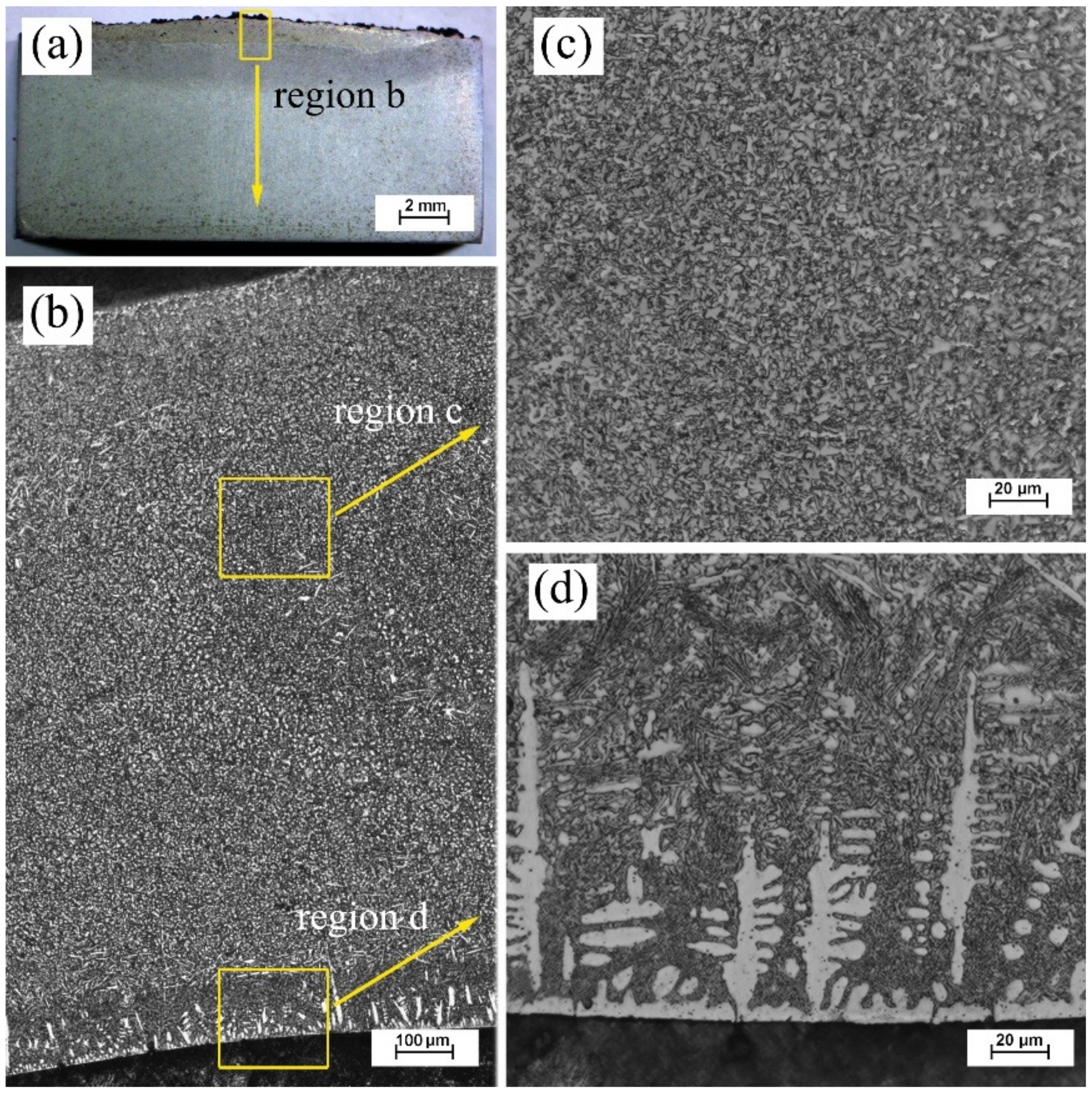

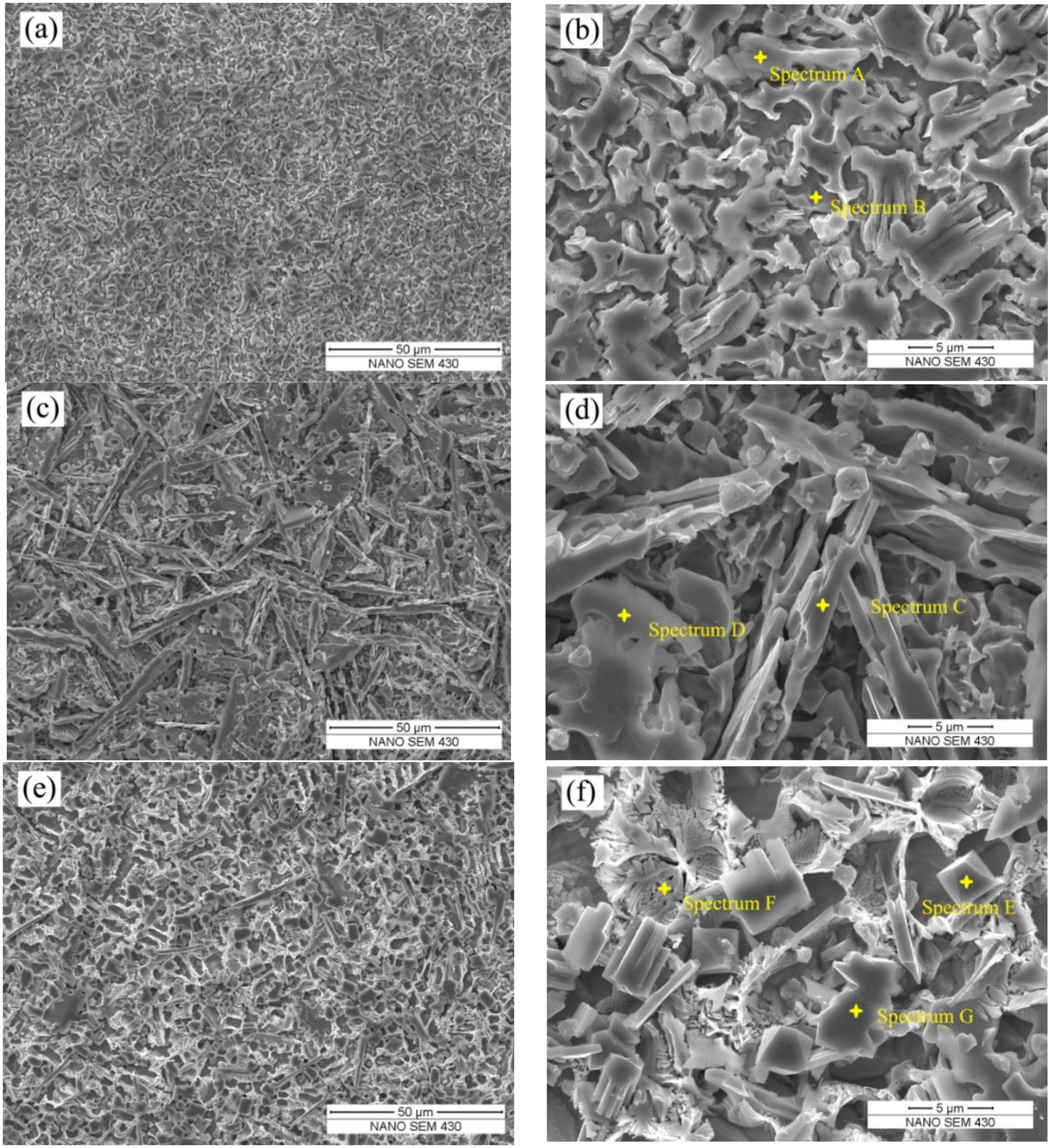
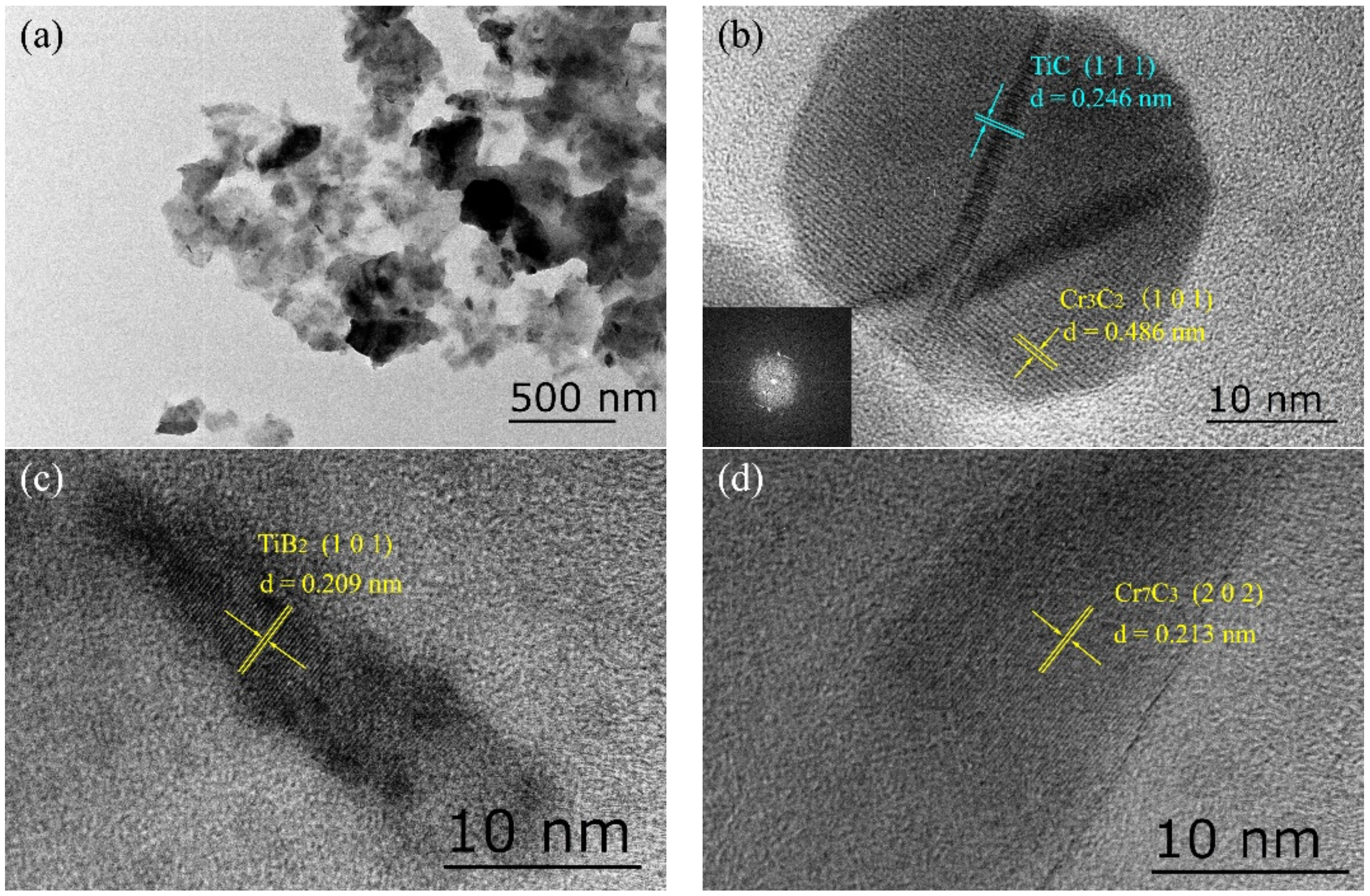

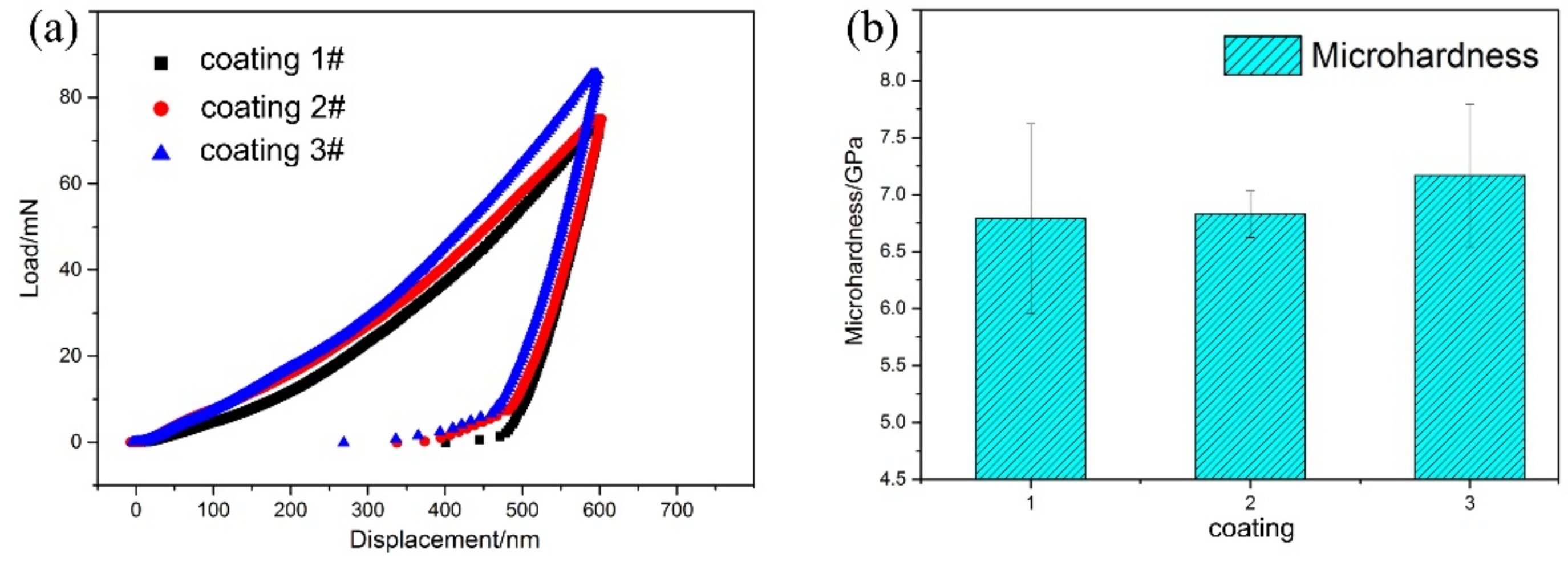
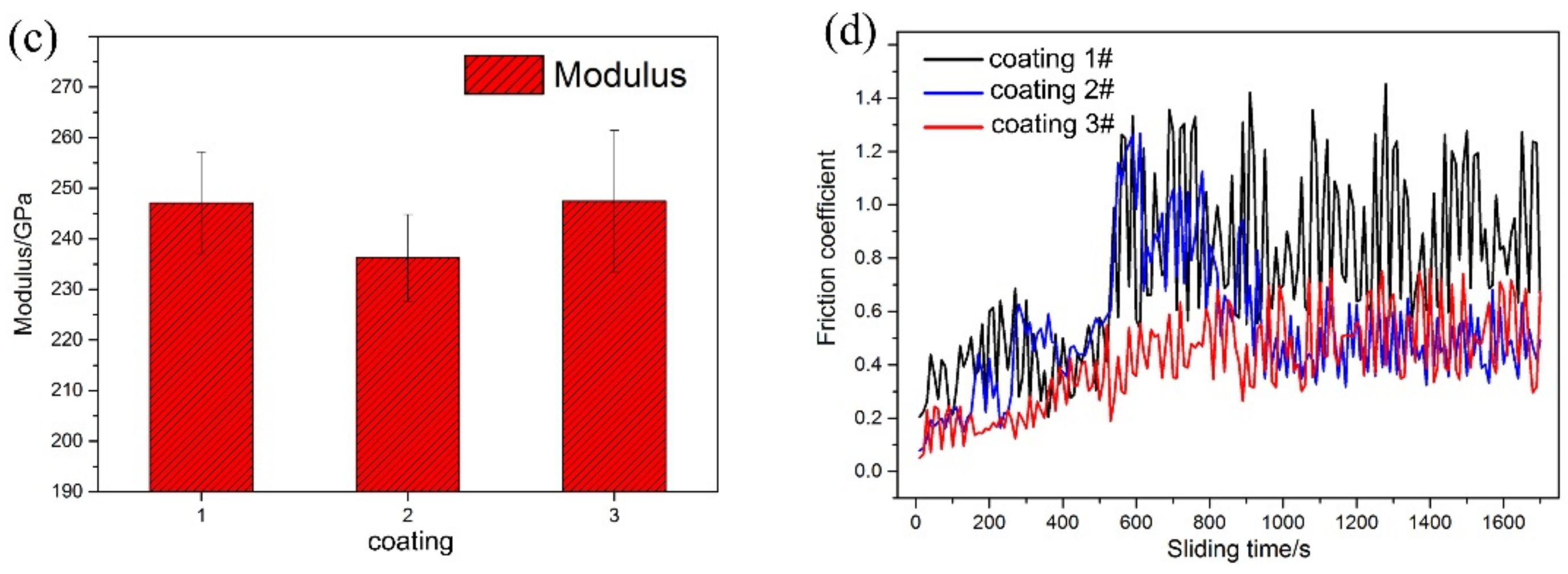
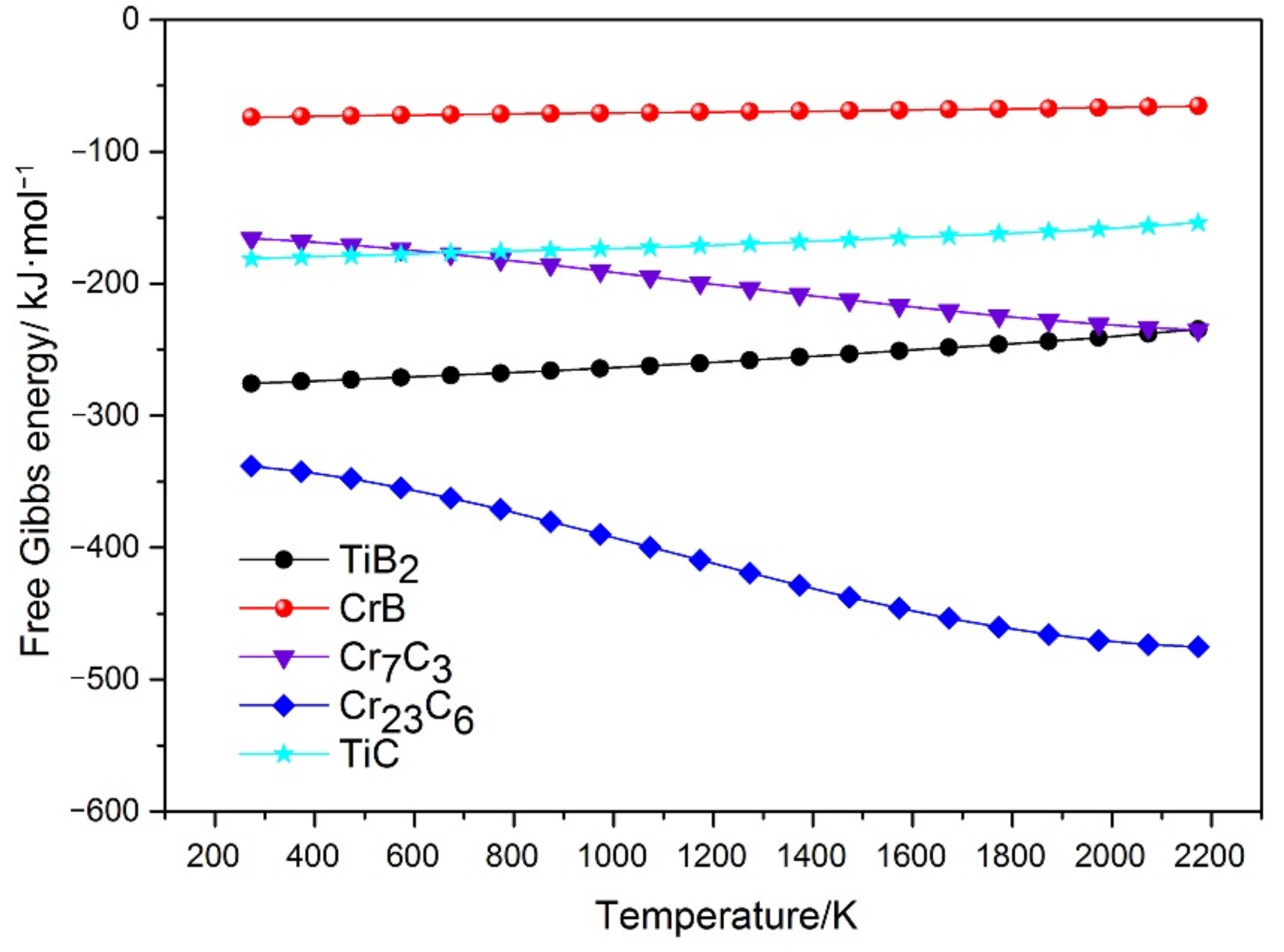
| Sample | Point | C | Ni | Cr | Fe | Ti | Probable Phase |
|---|---|---|---|---|---|---|---|
| 1# | A | 1.26 | 24.00 | 32.85 | 37.89 | – | Cr7C3 + γ-Ni |
| B | – | 66.50 | 6.20 | 27.30 | – | γ-Ni | |
| 2# | C | 4.15 | 7.39 | 46.48 | 35.73 | 6.24 | Cr7C3 + TiC |
| D | 1.37 | 57.30 | 7.64 | 30.82 | 2.88 | γ-Ni | |
| 3# | E | 1.92 | – | 79.08 | 8.55 | 10.45 | CrB |
| F | 0.99 | 9.54 | 50.81 | 37.16 | 1.50 | Cr23C6 + γ-Ni | |
| G | 1.34 | 69.02 | 3.50 | 18.97 | 7.18 | γ-Ni |
Publisher’s Note: MDPI stays neutral with regard to jurisdictional claims in published maps and institutional affiliations. |
© 2021 by the authors. Licensee MDPI, Basel, Switzerland. This article is an open access article distributed under the terms and conditions of the Creative Commons Attribution (CC BY) license (http://creativecommons.org/licenses/by/4.0/).
Share and Cite
Ma, Q.; Dong, Z.; Ren, N.; Hong, S.; Chen, J.; Hu, L.; Meng, W. Microstructure and Mechanical Properties of Multiple In-Situ-Phases-Reinforced Nickel Composite Coatings Deposited by Wide-Band Laser. Coatings 2021, 11, 36. https://doi.org/10.3390/coatings11010036
Ma Q, Dong Z, Ren N, Hong S, Chen J, Hu L, Meng W. Microstructure and Mechanical Properties of Multiple In-Situ-Phases-Reinforced Nickel Composite Coatings Deposited by Wide-Band Laser. Coatings. 2021; 11(1):36. https://doi.org/10.3390/coatings11010036
Chicago/Turabian StyleMa, Qunshuang, Zhengxue Dong, Nannan Ren, Shenlizhi Hong, Jinxing Chen, Lei Hu, and Wei Meng. 2021. "Microstructure and Mechanical Properties of Multiple In-Situ-Phases-Reinforced Nickel Composite Coatings Deposited by Wide-Band Laser" Coatings 11, no. 1: 36. https://doi.org/10.3390/coatings11010036
APA StyleMa, Q., Dong, Z., Ren, N., Hong, S., Chen, J., Hu, L., & Meng, W. (2021). Microstructure and Mechanical Properties of Multiple In-Situ-Phases-Reinforced Nickel Composite Coatings Deposited by Wide-Band Laser. Coatings, 11(1), 36. https://doi.org/10.3390/coatings11010036




